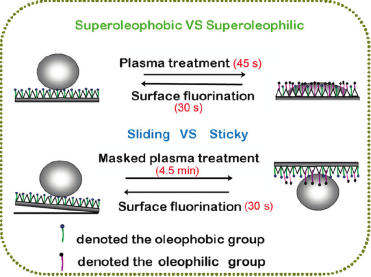The studies on functional superoleophobic surfaces have attracted much attention due to their wide applicability in various fields. However, the preparation of superoleophobic surfaces is much more difficult than that of superhydrophobic surfaces, resulting in fewer reports on superoleophobic surfaces.
The composite lubricating materials group at the R&D Centre of Lubricating and Protecting Materials, Lanzhou Institute of Chemical Physics, Chinese Academy of Sciences, has developed a facile approach to rapidly achieve the reversible wettability and adhesion transition to oil droplets on the copper substrate by alternation of plasma treatment and chemical modification.
After plasma treatment, the wettability of the surface varied from superoleophobic to superoleophilic; while plasma treatment through a mask led to a sticky superoleophobic surface. However, the plasma-treated surfaces recovered to their original superoleophobic state upon surface fluorination.
This novel and simple technology for achieving reversible wettability and adhesion should be applicable to other surfaces, and it does not typically require expensive materials or complicated processes. Moreover, the rapid wettability and adhesion transition to oil droplets could be potentially valuable in smart devices, such as microfluidic devices and smart membrane.
The work has received support from the National Natural Science Foundation of China (NSFC) and National Program on Key Basic Research Project of China (973 Program).
The findings have been published in Langmuir (Langmuir, 2011, 27, 14508–14513).
Langmuir Paper

Schematic illustration showing the method for achieving switchable wettability and adhesion transition to oil droplets. (Image by ZHANG Zhaozhu et al.)

